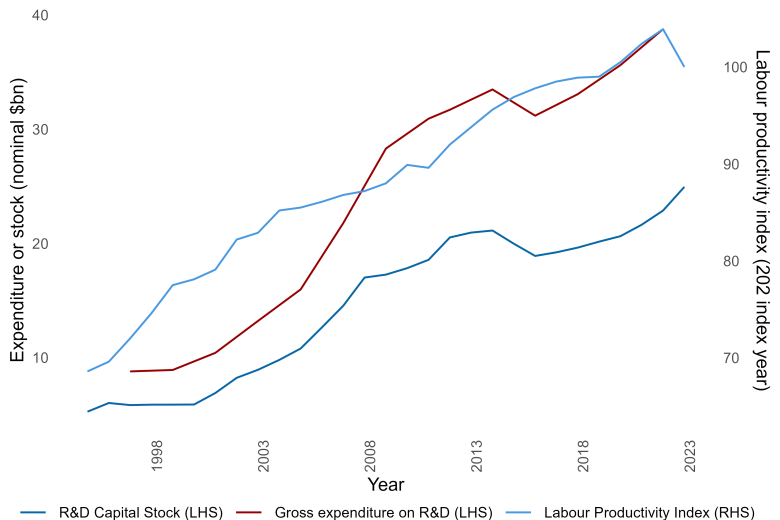R&D impacts are maximised when paired with other factors
But is the relationship this simple? Or are there additional factors at play?
R&D alone is not always enough to lift the innovation, and productivity, of businesses. It needs to be paired with avenues of commercialisation and integration of innovation into work practices. Businesses need to find the right skills, experience competitive pressure to drive change, and match with trade and finance opportunities. This is because, for many businesses, R&D may only affect productivity indirectly.
Crucially, many of the benefits from investing in the application of R&D accrue to business and individuals outside of the firm that makes the investment. These ‘spillover’ benefits are why governments work with the research and business community to grow Australian R&D and to leverage its impact.
Businesses conducting R&D support innovation in the wider economy by increasing the stock of knowledge and its possible uses. This action helps push forward the technology and knowledge frontier (OECD, 2015b). Investment in R&D creates the expertise needed to be able to understand and contribute to the leading edge of knowledge and to adapt and adopt innovations and technology from all sources. There is evidence that businesses conducting R&D are more productive and better at adopting existing innovations (IMF, 2021).
However, most Australian businesses do not conduct R&D themselves nor create new innovations. In 2022–23, only 16% of Australian businesses reported having any R&D expenditure. Additionally, only 2% of Australian businesses introduced newly created (that is ‘new to the world’) innovations (ABS, 2024b [DISR calculations]).
Instead, most Australian businesses currently increase productivity by adopting existing innovations, also known as innovation diffusion.
As a result, the benefit of R&D to Australian businesses depends both on the efforts of firms to adopt existing innovations, as well as those creating new ones through R&D (Productivity Commission, 2023).
Growing Australia’s innovation system requires more than R&D investment
The AIS conceptual framework covers a range of the most important enabling factors that need to work with R&D investment to promote productivity growth. These include:
- the exchange of ideas, skills and technology through trade and migration
- access to innovation skills, finance and collaboration
- market competition (where innovation can give an edge on competitors).
As covered in our snapshot of Australian innovation, Australia’s innovation performance is improving in some of these areas, while mixed in others. We’ve got better at bringing in ideas from overseas and domestic collaboration. However, acquiring skills and matching businesses with sources of innovation finance are major challenges.
Other recent research suggests a long-term trend where Australian businesses are adopting new innovations at slower rates. This trend may be linked to observed reductions in business dynamism and competition in recent decades. As less dynamic and competitive industries are slower to adopt new technologies (Andrews et al., 2022).
Alongside R&D investment, a focus on these wider range of factors, will be important to improving Australia’s innovation system and to promote productivity growth.

